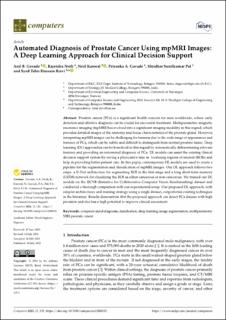| dc.contributor.author | Gavade, Anil B. | |
| dc.contributor.author | Nerli, Rajendra | |
| dc.contributor.author | Kanwal, Neel | |
| dc.contributor.author | Gavade, Priyanka A. | |
| dc.contributor.author | Pol, Shridhar Sunilkumar | |
| dc.contributor.author | Rizvi, Syed Tahir Hussain | |
| dc.date.accessioned | 2023-08-23T10:08:50Z | |
| dc.date.available | 2023-08-23T10:08:50Z | |
| dc.date.created | 2023-07-29T13:08:12Z | |
| dc.date.issued | 2023 | |
| dc.identifier.citation | Gavade, A. B., Nerli, R., Kanwal, N., Gavade, P. A., Pol, S. S., & Rizvi, S. T. H. (2023). Automated Diagnosis of Prostate Cancer Using mpMRI Images: A Deep Learning Approach for Clinical Decision Support. Computers, 12(8), 152. | en_US |
| dc.identifier.issn | 2073-431X | |
| dc.identifier.uri | https://hdl.handle.net/11250/3085396 | |
| dc.description.abstract | Prostate cancer (PCa) is a significant health concern for men worldwide, where early detection and effective diagnosis can be crucial for successful treatment. Multiparametric magnetic resonance imaging (mpMRI) has evolved into a significant imaging modality in this regard, which provides detailed images of the anatomy and tissue characteristics of the prostate gland. However, interpreting mpMRI images can be challenging for humans due to the wide range of appearances and features of PCa, which can be subtle and difficult to distinguish from normal prostate tissue. Deep learning (DL) approaches can be beneficial in this regard by automatically differentiating relevant features and providing an automated diagnosis of PCa. DL models can assist the existing clinical decision support system by saving a physician’s time in localizing regions of interest (ROIs) and help in providing better patient care. In this paper, contemporary DL models are used to create a pipeline for the segmentation and classification of mpMRI images. Our DL approach follows two steps: a U-Net architecture for segmenting ROI in the first stage and a long short-term memory (LSTM) network for classifying the ROI as either cancerous or non-cancerous. We trained our DL models on the I2CVB (Initiative for Collaborative Computer Vision Benchmarking) dataset and conducted a thorough comparison with our experimental setup. Our proposed DL approach, with simpler architectures and training strategy using a single dataset, outperforms existing techniques in the literature. Results demonstrate that the proposed approach can detect PCa disease with high precision and also has a high potential to improve clinical assessment. | |
| dc.language.iso | eng | en_US |
| dc.publisher | MDPI | en_US |
| dc.rights | Navngivelse 4.0 Internasjonal | * |
| dc.rights.uri | http://creativecommons.org/licenses/by/4.0/deed.no | * |
| dc.subject | maskinlæring | en_US |
| dc.subject | prostatakreft | en_US |
| dc.subject | mpMRI | en_US |
| dc.subject | computer-aided diagnosis | en_US |
| dc.title | Automated Diagnosis of Prostate Cancer Using mpMRI Images: A Deep Learning Approach for Clinical Decision Support | en_US |
| dc.type | Peer reviewed | en_US |
| dc.type | Journal article | en_US |
| dc.description.version | publishedVersion | en_US |
| dc.rights.holder | © 2023 By The Author(s). | en_US |
| dc.subject.nsi | VDP::Teknologi: 500::Informasjons- og kommunikasjonsteknologi: 550 | en_US |
| dc.subject.nsi | VDP::Medisinske Fag: 700::Klinisk medisinske fag: 750::Onkologi: 762 | en_US |
| dc.source.volume | 12 | en_US |
| dc.source.journal | Computers | en_US |
| dc.source.issue | 8 | en_US |
| dc.identifier.doi | 10.3390/computers12080152 | |
| dc.identifier.cristin | 2163932 | |
| dc.source.articlenumber | 152 | en_US |
| cristin.ispublished | true | |
| cristin.fulltext | original | |
| cristin.qualitycode | 1 | |

